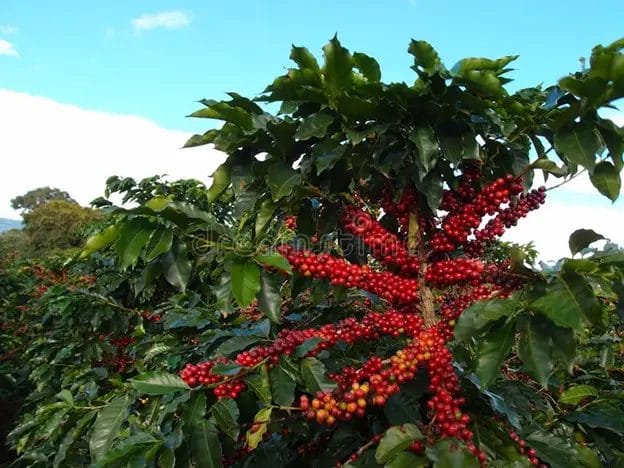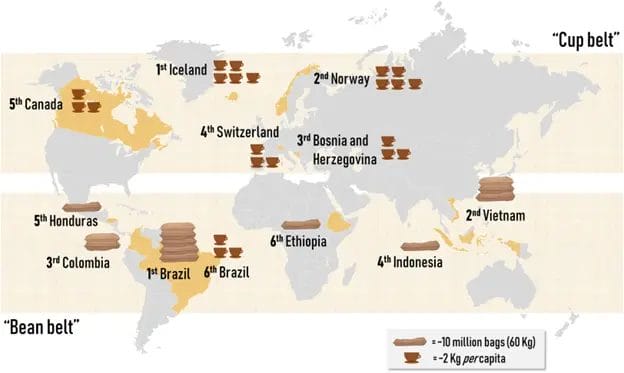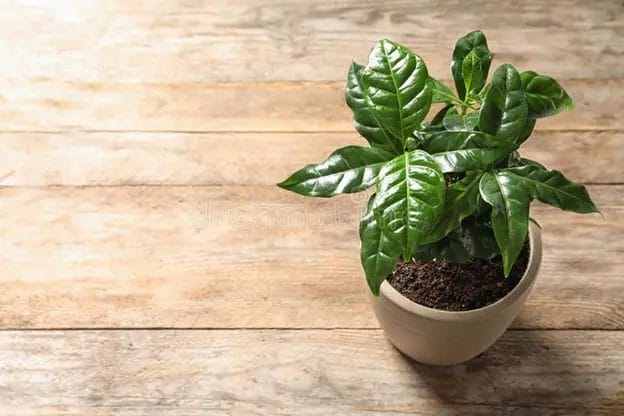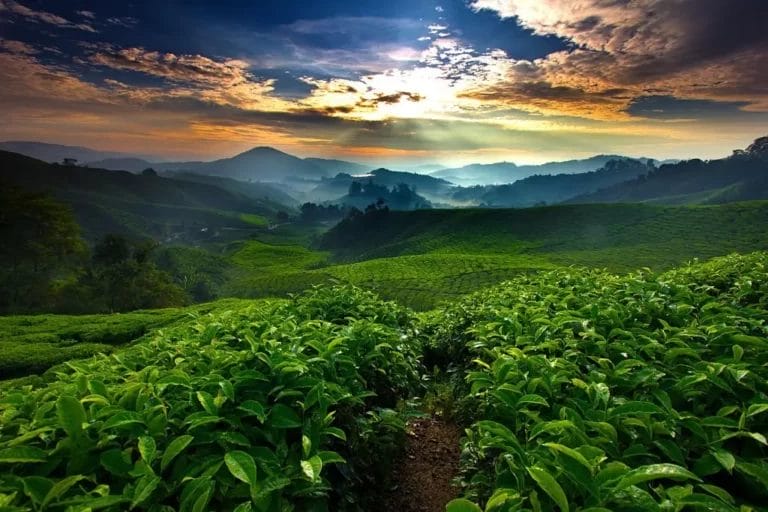The magical bean that comes and makes the whole world a better place comes from a tree, obviously. To be more specific, The coffee comes from coffee cherry fruit.
Roasted coffee beans that each coffee lover enjoys are seeds found inside the fruit. And the fruit originates from coffee plants.
Whenever I say coffee, what is the first thing that comes to your mind? Your answer probably is “freshly roasted coffee beans.” But why is it not the tiny cherries or the coffee plants? The coffee tree is the mother of the bean that gives its birth.

Are you curious to understand more about coffee plants? Let Coffeenom help you! Here is an explanation about the coffee plant inside out.
About Coffee Plants
Coffee trees belong to the botanical family Rubiaceae, genus Coffea. African forests are partially colonized with plants of the Coffea species.
A coffee bush grows from a coffee seed planted in well-fertilized soil. Believe it or not, the coffee genus consists of hundreds of different trees and shrubs. These trees and bushes flourish best at high altitudes in mild tropical and sunny climates.
Coffee plant growth starts within 3-4 months of the plantation. The coffee bean hangs at the top of the baby plant. From the porous bean, the first leaves unfold.

Depending on the type of coffee plants, each possesses different characteristics. For example, some species of coffee plants grow up to ten meters in height and form trees. While others are small, like shrubs.
The bushes start blooming after 3-4 years, thanks to self-pollination. So the coffee bushes can produce coffee cherries for 20 years.
The flowers give birth to coffee cherries in 9 months. The harvest season starts when the coffee cherries have ripened.
Anatomy of A Coffee Plant
Leaves & Branches
The paired, waxy leaves are where photosynthesis takes place. It is a process that gives the trees the necessary energy to grow.
Each leaf has an ovate shape with a pointed base and tip. The leaves can be up to 16’ in length. Uncommon varieties of coffee trees have purple or yellow leaves.
The branches grow in pairs and in a near-horizontal position opposite one another.
Flowers
The white coffee flower grows on the branches of the coffee tree branches. Coffee flowers are small and white, and they smell and look lovely, just like jasmine. The pleasant aroma attracts you to stay in that environment.
The flowers are the most vital part of the coffee plant since the reproductive organs are located.
Fruits
The cherry-like fruit grows on the branches of the flowers. A Coffeeberry is small in size, about half an inch. The color of coffee cherries gradually goes from green to dark red. A bright red color of the fruit characterizes a ripe fruit ready to be harvested.
Coffee fruits are classified as stone fruit or drupe, which grows when the flower grows in the coffee plant. Therefore, we call it coffee cherry, resembling ripe cherries ready for production.
Beans
Green coffee beans grow in pairs inside the fruit. Therefore, everything from the plant type, soil, and climate will affect the final coffee flavor.
When the beans are paired inside the cherry, one side of a bean is flat, while the opposite part is convex. Therefore, a cherry contains a single bean when a failed pollination occurs. This failure can occur due to either natural mutation or a defect in the cherry itself.
After coffee beans are extracted from the fruit, some farmers dry these leftovers in the sun to produce cascara.
Plant
Coffee plants can grow up to 32 feet tall in the wilderness. So farmers in almost all coffee farms prune these trees down to 6 feet. You might think it’s a cruel thing to do, but it serves multiple purposes.
Coffee farmers can pick the coffee cherries far more quickly from a lesser height. Also, a tree conserves more of its nutrition by growing a shorter length.
Variety of Coffee Plants
There is a wide variety of coffee plantations, where each species produce different coffee plants containing different tastes and caffeine contents. However, the dominating types in the coffee industry include Arabica, Robusta, and Liberica coffee.
Arabica
Also known as the “evergreen tree,” an Arabica coffee plant is sensitive and difficult to cultivate compared to Robusta coffee plants. Production of less Arabica coffee per hectare makes it more expensive. Another reason for the high price is the ensured quality of the beans through selective picking.
Arabica beans are of superior quality, tastier, and most popular variety. Arabica bean makes up 60-70% of global coffee production, making it the most produced coffee variety in the coffee market. In addition, the green beans of Arabica carry less caffeine content compared to Robusta.
The Coffea Arabica plant needs a low pH value, high moisture, and a little shade. Therefore, they grow best in mountainous climates of altitude of between 600-2200 meters.
The ideal temperature to raise the Arabica plant is 15-24 oC. Plant heights lie between 2.5-4.5 meters commercially. But, in the wilderness, the plant can grow from 9-12 meters.
Robusta
C Canephora, better known as the Robusta plants, are produced on large tracts of land. As a result, robusta plants are more resistant to natural disasters, weather, and pests due to the higher caffeine content present in the robusta bean. Harvest of Robusta beans may not be as much as Arabica, but it is still a significant amount of 30-40% of global production.
Coffea Robusta plants thrive at low altitudes between 0-800 meters above sea level, growing between 4.5-6.5 meters long. The optimum temperature is 18-36 oC, and a lot of rainfall.
Liberica
Liberica plants thrive best in a climate that is hot, humid, and at low altitudes. Cherries have a lengthier maturation time than Arabica or Robusta fruits, 12-14 months. Liberica trees have a longer lifespan and grow up to 20 meters in height. They are very resistant to parasites.
Liberica plants make up only two percent of global coffee production, and that too, barely. Liberica plants have faced near-extinction events more than once, causing the price to hike really high.
Well, There’s another coffee bean you may also like to know about. Read out our what is Kona coffee article.
The Coffee Belt
The coffee belt represents locations where coffee plants thrive the most. It is an invisible strip around the globe. This particular part of the world provides ideal conditions for coffee’s growth. There are both dry and rainy seasons in the bean belt with heavy rainfall.

The belt is located along the equator between 25° North and 30° South. It lies between the tropics of Cancer and Capricorn. The strip extends from Central America and South America to Africa and Asia. The mysterious horizontal strip includes more than 50 countries. The largest producer of coffee worldwide, Brazil, is also within the coffee bean belt.
Coffee-growing regions require rich and fertile volcanic soil. The soil provides vital nutrients to the coffee plants. The Arabica plants grow on high altitudes between 1000 to 2000 meters above sea level.
The magical stretch of the bean belt fulfills all these conditions. Therefore, the bean belt is vital to growing the best quality coffee beans. The richness of the beans we all crave results from this exceptional environment.
Learn more from our coffee bean belt article.
Can You Grow Indoor Coffee Plants?
The indoor coffee plant is an ideal houseplant. It can be a beautiful house ornament alone or in pairs with other plants. Small bushes can enhance the cozy beauty of a tabletop, family room, or bedroom.

Its leaves are glossy, like being polished. You may trim the bush whenever it gets bigger. Trimming makes it denser.
To grow coffee plants indoors, you need a bright room with a lot of sunlight. But avoid harsh sunlight from directly reaching the plant. That will turn the shiny green leaves into faded browns.
Water the plant in enough amounts at least weekly. They love the moist soil. But remember, too much water is their enemy. The plant also appreciates high humidity. If your environment is too dry, use mists or trays to boost humidity.
Fertilizer is not an absolute necessity. But you can fertilize the plant to make it flourish and grow faster. Make sure to not fertilize during winters.
Had Fun? You might also want to know which countries produce coffee. Read out our coffee-producing countries article.
Bottom Line
Let us all take a moment to be thankful for the existence of coffee plants. Without them, we wouldn’t have coffee today, and all the coffee drinkers in the world would probably be stuck drinking tea.
This makes me think about the guy who first discovered that you can grind the beans of a particular fruit and heat them in water to create an energy drink. What was that guy thinking?
FAQs
The plant itself does not spread scents. But coffee plants flourish with white, small, and star-shaped flowers. They both look and smell like jasmine.
Dry soil or overwatering are the enemies of coffee plants that turn the leaves brown. Also, low humidity can dry out the leaves, and they turn brown. Sunlight is another factor. Direct sunlight reaching the plants makes the leaves turn brown.
The coffee plants have small, white, star-shaped flowers, shiny dark green leaves that grow in pairs, and cherry-like fruits. The flowers smell and look like jasmine. The color of coffee cherries goes gradually from green to dark red. Coffee beans grow in pairs inside the fruit.
A newly planted baby coffee plant needs about 3 to 4 years to start blooming. The time frame depends mainly on the variety of coffee plants. Coffee plants undergo self-pollination, and the flowers give birth to coffee cherries within 9 months.
Coffee plants contain toxic elements to repel insects and protect the plants. Avoid going near coffee plants if you own a pet. Dogs and cats may get harmed by the toxicity of coffee plants. As a result, it may cause them to vomit and lead to diarrhea.
Do you think you can grow coffee plants from the beans brought from the supermarket? You are wrong. It is not possible. The beans that we use to make a delicious cup of coffee have been processed. They are treated with heat and roasted. So, these beans are unable to produce plants.
Fertilizing every 2-3 months is necessary during the warmer season. Some great fertilizers for coffee plants are citrus, rose, and coffee grounds. The coffee grounds contain the appropriate nutrients that the plants require. But, during the winter season, avoid fertilizing them.

